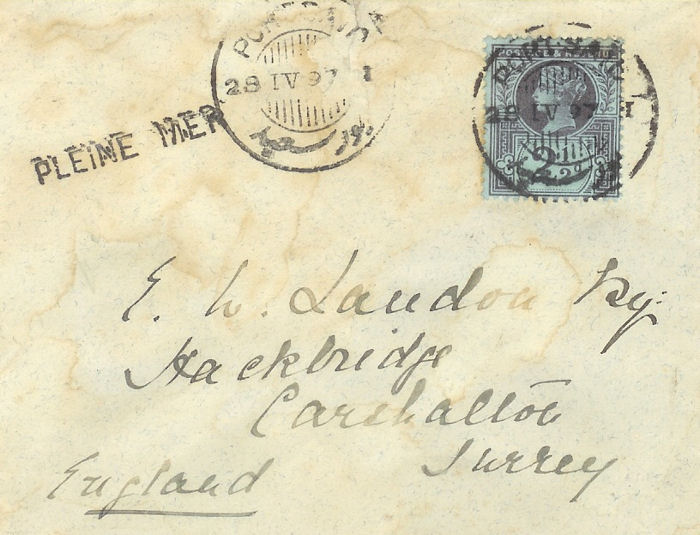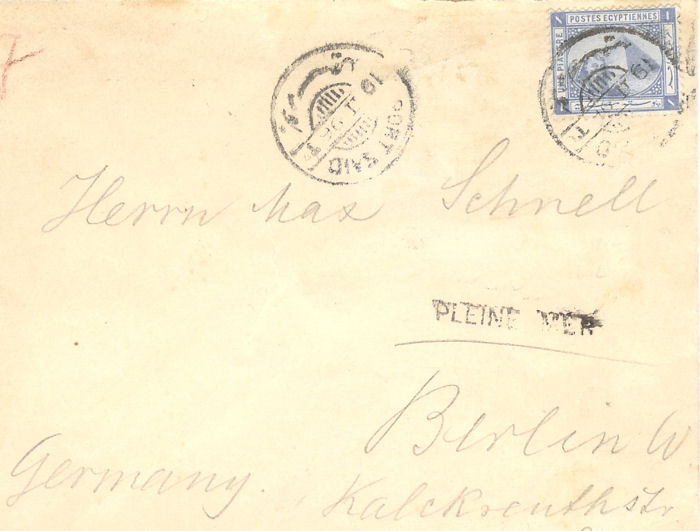Seapost -> Pleine Mer Cancels
Pleine Mer Cancels
By Mike Dovey
It was in Vienna in 1891 that rules were first adopted relating to mail posted on the high seas and, as the official language for the Universal Postal Union was French, it was the Egyptian Post Office that was the very first to adopt a mark based in French for use with High Seas mail. The term "Pleine Mer", meaning "High Seas" in French, was adopted and the mark issued to the post offices in Alexandria, Port Said and Suez for use in 1892. These marks therefore predated the first usage of the "Paquebot" cancellations which came into being in January 1894 at a number of post offices around the world. While the term "Paquebot" was not officially adopted by the UPU until the Washington convention in 1897 it had been widely used by many countries including Britain, France, and the USA for over three years following its first introduction.
    |
|||
| 1. PORT SAID (1892 – 1898) |
2. SUEZ (1892 – 1898) |
3. ALEXANDRIA (1892 – 1902) |
4. VALLETTA |
    |
|||
| 5. (1892 – 1902) | 6. (1925) | 7. ALEXANDRIA (1892 – 1925) |
8. (1925) |
The "Pleine Mer" cancellation was first used at all three ports of call in Egypt and examples are well known from the starting date of 1892, especially Figs 1 and 2 (Port Said and Suez) which have been documented in Roger Hosking's book for many years as cancellation types 2856 and 2877. Although Fig 5 is known used in the same time period, it has still to be allocated to a port of call.
It is only in the last ten years that Figs 3 and 7 have been allocated to Alexandria. As usage ceased over 100 years ago it seems a long time to wait to allocate a mark, especially as Fig 7 was in use for a far longer period than any other "Pleine Mer" cancellation.

Plein Mer cancel of PORT SAID (Hosking 2856C) dated 28th April 1897, GB franking.
In the cover illustrated above, note how the usage is similar to that of the conventional 'Paquebot' strike, away from the stamp, which has been cancelled locally.
The mark in Fig 4 is the only one of the eight that does not originate from Egypt and the reasons for the mark are unclear. The G.P.O. Record Book in London shows that on the 19th September 1893 two identical marks were issued to the Colonial Postmaster, Malta, as a "rubber handstamp in violet", presumably for use in Valletta. However, they were never used as at the end of January 1894 the British Omnibus cancellation (Hosking 22D) was issued and used. It is not known why the earlier mark was sought or issued but it is likely that it was the need to cancel mail to and from Egypt that may have prompted the Postmaster at Valletta to ask London for such a mark, only to be countermanded a few months later with the new Paquebot cancel.
The marks in Figs 6 and 8 are the ones with the big question mark. They are both used only in 1925, and both on envelopes with a Saudi Arabia 3c stamp. Fig 6 is clearly Fig 8 without the frame and as they have never been allocated to a port of call they must be noted as "need checking" until the truth can be ascertained. It is also worth noting that Fig 7's latest usage in 1925 is with the same type of envelope using a Saudi Arabian 3c stamp. Presumably there was a collector, maybe, even in 1925 who sought and obtained covers at the very end of their life span.

Another Plein Mer cancel of PORT SAID ( Hosking 2856C) this dated 19th February 1896, Egyptian franking.
Editor's note: Many ships passed through Port Said and Suez on their way from Europe to the Far East. Such journeys would afford ample opportunity for letter writing during the voyage. It is therefore not surprising that Plein Mer handstamps would have been issued to ports at each end of the Suez Canal where, since 1888, the canal was a neutral zone under the protection of the British.
References
Some information for this article has been taken from an article published by Charles W Minett in 1965 for the BAPIP Bulletin No 48 and another in No 52 in 1966.
See also Paquebot Cancellations of the World by Roger Hosking (Third edition) 2000.
The Royal Philatelic Society London web site contains articles by the Egypt Study Circle concerning Plein Mer use. The study circle's site has more examples of Plein Mer cancels as well as information about Egyptian TPOs.

